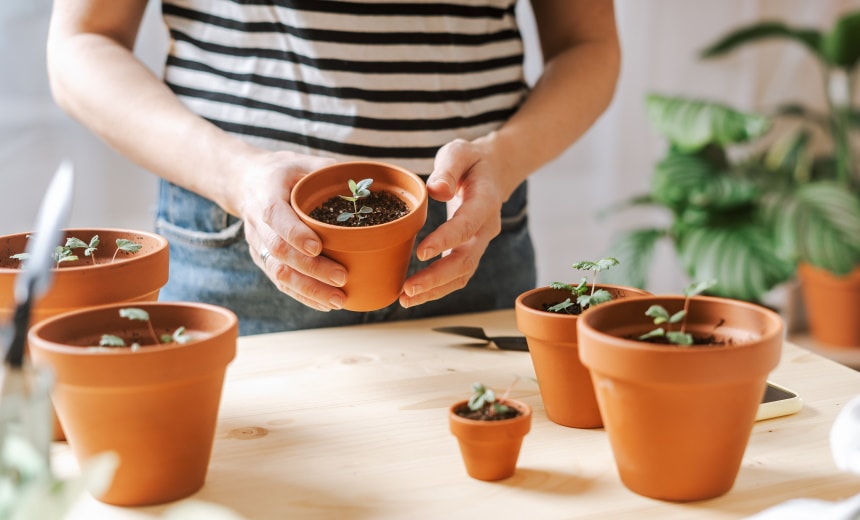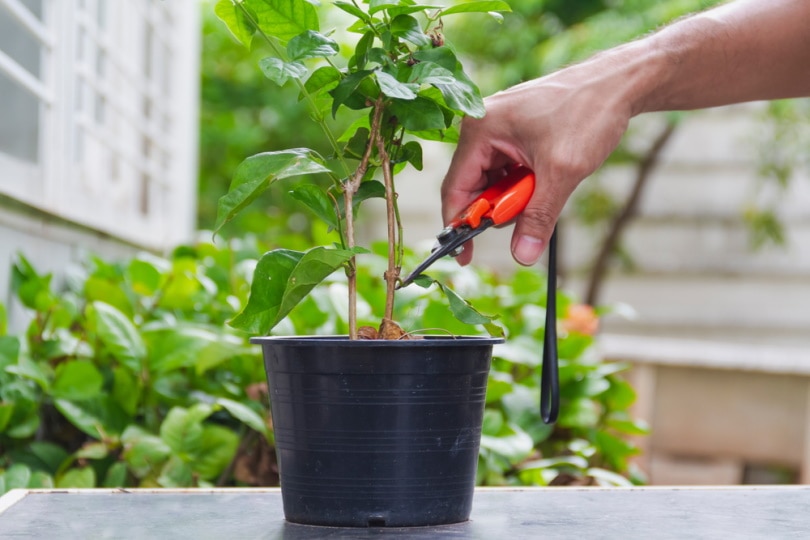How to Grow Jasmine Indoors: Step-By-Step Guide (With Pictures)
-
- Last updated:

Sometimes, the simple things in life give us the most pleasure. One example is the sight of a jasmine plant with its delicate white blooms.
Jasmine plants are native to tropical areas, but many people grow them indoors. If you’re looking for an indoor plant that will bloom most of the year, consider the jasmine plant. It is one of the easiest plants to grow indoors.
There’s something about the jasmine plant’s scent that is uplifting and romantic. It is one of the most beloved, fragrant flowering vine plants worldwide. Once you get the hang of growing jasmine indoors, you will wonder why you waited so long to start.
Here are some simple steps on how to grow jasmine indoors and get your first fragrant bouquet. Keep reading!

What’s the Best Place to Grow Jasmine Indoors?
Before you start, it’s crucial to identify the best position to grow jasmine plants indoors. You can grow it in any bright room. A south-facing window would be an ideal spot. It can also thrive in a west-facing window, but it won’t do well in an east-facing window or rooms without enough light.
- Potting soil
- Saw
- Medium-sized planter
- Lattice
- 10-20-10 fertilizer
Step-By-Step Guide for Growing Jasmine Indoors
Here are the steps you need to take to successfully grow jasmine indoors:
1. Put the Jasmine in a Medium-Sized Planter

Jasmine is a fast-growing vine that needs a sturdy support system to keep it from toppling over. You can provide this support by growing the plant in a large planter at least 12 inches deep and wide.
Fill the bottom of the container with 1–2 inches of small rocks to allow for drainage. Then, fill the rest of the pot with high-quality, well-draining soil. Place the plant so that its roots are below the soil surface. Then, pat the soil to keep it in place.
Use a saw to cut a piece of wooden lattice. Make sure that it fits in the planter. Position the lattice in a way that jasmine vines can crawl through and up it.
2. Water Your Jasmine Plant

Jasmine plants need regular, consistent watering to stay healthy. These plants prefer moisture in their soil rather than dryness. The plants may begin to wilt if their soil remains dry for too long.
Check your jasmine plant daily for signs of wilting or drying out and water it whenever the top inch or two of soil feels dry.
3. Fertilize Your Jasmine Every 2 Weeks

Jasmine should be fertilized often during their flowering period. Fertilize them less often during the winter and spring seasons. Fertilizing them once every 2 months will suffice while they bloom.
Use a 10-20-10 fertilizer that contains potassium, phosphorus, and nitrogen in the ratio of 1:2:1. The high percentage of phosphorus boosts their growth.
4. Put the Jasmine Plant in Direct Sunlight
Place your jasmine plant in a location that receives direct sunlight for at least 6 hours per day. Flowers will not form on the jasmine plant if it does not receive adequate sunlight.
The plant grows well in windows that face south or west. If you do not have a window that provides adequate sunshine, place the plant under fluorescent lights.
5. Repot and Prune the Jasmine Plant After Blooming

Trim off dead or damaged branches after flowering to promote new growth. It’s also crucial to remove long vines that may creep around the pot to keep the plant looking bushier and fuller.
Besides, pruning helps your jasmine stay a manageable size. This way, you can move it indoors during the winter months. That’s, of course, if you live in a climate that experiences freezing temperatures.

How Do You Propagate Jasmine?
You can propagate jasmine using two different methods. These methods include planting jasmine seeds and rooting jasmine cuttings.
- Planting Jasmine Seeds: Fill small pots with standard potting soil and water it until it’s completely moist but not soggy. Sow the seeds 1/4 inch deep in the pots. Then, mist them with a spray bottle to keep them moist until they germinate.
- Rooting Jasmine Cuttings: The key to rooting jasmine cuttings is keeping them moist for the first few weeks until they root. Wrap each cutting in plastic after inserting it into a pot filled with moist potting soil or sand. This helps with moisture retention and prevents fungal diseases from developing.

Jasmine Varieties Best for Indoor Growing
Jasmine has become popular for things like aromatherapy and warding off mosquitoes and other pests. There are many varieties of jasmine. Are you wondering which one will work best for growing within your home? If so, here are several jasmine varieties that you can grow indoors:
- Arabian Jasmine: Arabian jasmine (Jasminum sambac) has small, star-shaped white flowers. Usually, they appear from summer through autumn. Unlike other varieties, it doesn’t need pruning. The vine grows from 2–8 feet tall. This plant needs full sun with well-draining soil and should be fertilized every month during summer and spring. It’s the best plant to have if you have a spacious balcony.
- Common Jasmine: Common Jasmine (Jasminum officinale) is a deciduous climbing or trailing vine. It has the heaviest scent of all jasmine varieties, which makes it an ideal choice for growing indoors. Common Jasmine grows best in full sun and rich, well-draining soil.
- White Jasmine: White Jasmine (Jasminum polyanthum) is also known as pink jasmine. It’s a popular indoor variety that is easy to grow. However, it may take a few years to reach its full height of 6–8 feet. White jasmine blooms in the spring and summer.
- Spanish Jasmine: Spanish Jasmine (Jasminum grandiflorum) is one of the most fragrant types of jasmines perfect for growing indoors. It grows 6–12 feet long and has fragrant white flowers that bloom in the spring and summer. Spanish Jasmine does better if you don’t prune it often.
- Winter Jasmine: Winter Jasmine (Jasminum nudiflorum) is also known as yellow jasmine. It grows to a height of about 6 feet. It has thin, yellow flowers that bloom in the winter. It also needs full sun and well-draining, acidic soil. As its name suggests, it doesn’t bloom until winter.

Tips and Tricks for Growing Jasmine Indoors
Growing jasmine indoors doesn’t have to be challenging. There are many excellent tips and tricks you can use to ensure you have a happy and healthy plant. Here are a few of them:
Choose a Suitable Jasmine Plant
Not all jasmines are suitable for growing indoors, so make sure you choose the right one. It’s best to buy a jasmine plant that has been grown in a nursery. It will have roots that are well-suited for indoor growth.
Position and Potting Mixture
When planting jasmine indoors, consider what type of soil the plant needs, which is well-draining and fertile soil. It can be sandy-loamy soil and it should be rich in organic matter. A good example is a mixture of peat moss, perlite, and potting soil.
Jasmine plants don’t need to be pruned, but they need to be trained and tied to the support structure you provide them with. If your container is large enough and has adequate drainage along the bottom and sides, you can plant the jasmine right into it.
Temperature
Jasmine plants grow well outdoors in warm temperate climates. You can grow it indoors in cooler regions with some care.

Sunlight
You’ll need a location that gets at least 6 hours of direct sunlight daily. If you don’t have enough light, you can use artificial light sources, such as fluorescent or LED bulbs. Check the label for the appropriate wattage for your space.
Fertilizing
Jasmine plants don’t need much fertilizer. However, applying some during its growing season can speed up its growth. It’ll also encourage the blooming of flowers.
Watering
Jasmine needs to be watered often, but without getting soaked. Keep the soil moist, but not overly wet.
After the plant blooms, reduce watering. If rainfall isn’t enough to keep the soil moist, provide supplemental water so it never dries out. Apply water at the base of the plant to minimize diseases.
Support Systems
Jasmine’s twining stems can be challenging to direct. Trellises are an invaluable tool for supporting vines and helping them grow upward, while still giving the plant room to spread out.
Still, the plants do not necessarily need a trellis. There may not be enough space to use a trellis if growing this plant indoors. Thankfully, some jasmine varieties will grow well without a trellis when grown in rich soil.

Uses of the Jasmine Plant
Jasmine is commonly used as an ornamental plant. It has fragrant white flowers, and it blooms in the winter season for an extended period. Usually, it attracts bees and butterflies.
The scent emitted from its flowers is used in perfumes. Below are other benefits of the jasmine plant.
- Excellent for the Skin: Jasmine is used to reduce skin irritation. It’s well known for its fragrance and soothing effect on the skin. Jasmine oil extracted from the flowers is rich in vitamin C, minerals, and antioxidants.
- It Has Antiseptic Properties: Jasmine has mild antiseptic properties that help in healing wounds fast. At the same time, it prevents infections and inflammation. The plant contains benzoic acid, benzaldehyde, and benzyl benzoate. All of these are antiseptics. Its oil also acts as an astringent that tightens the skin’s pores, thereby keeping your skin healthy and glowing.
- It Neutralizes and Purifies Air: The flowers of the jasmine plant are often placed in cupboards, drawers, and clothes to keep items smelling fresh and clean. Jasmine oil can be diffused in the air to improve its quality. It also neutralizes harmful odors.
- It Relaxes and Relieves Stress: Jasmine is known to have antidepressant properties due to its fragrance. Also, it has a calming and soothing effect on the nerves. It relaxes the body and mind, thereby improving sleep quality and preventing insomnia. Jasmine oil is also used in aromatherapy. It reduces tension and anxiety, lifts spirits, and improves confidence and self-esteem.
- Eases Menstrual Pain: The jasmine plant relieves menstrual pain. It has an estrogenic effect that can even help control mood swings, anxiety, and other symptoms associated with menstruation.
- It Assists in Weight Loss: Jasmine flowers are used to make tea known to impact weight loss. You can add jasmine leaves and flowers to your diet to promote weight loss. First, you have to boil them. Use 1 teaspoon of dried or fresh jasmine flowers per 1 cup of boiling water to make a refreshing jasmine tea.


Conclusion
Now you know how to grow jasmine indoors. It’s the perfect arrangement that you can use to brighten up your home, and you’ll have a plant that’s easy to propagate.
Still, if left to its own devices, it can become invasive in places you don’t want it. Be smart and plant it where it will do some good. This way, both you and the plant can benefit.
We hope this post has helped you identify how to grow jasmine indoors and has inspired you to do so.
Featured Image Credit: ntdanai, Shutterstock
Contents

